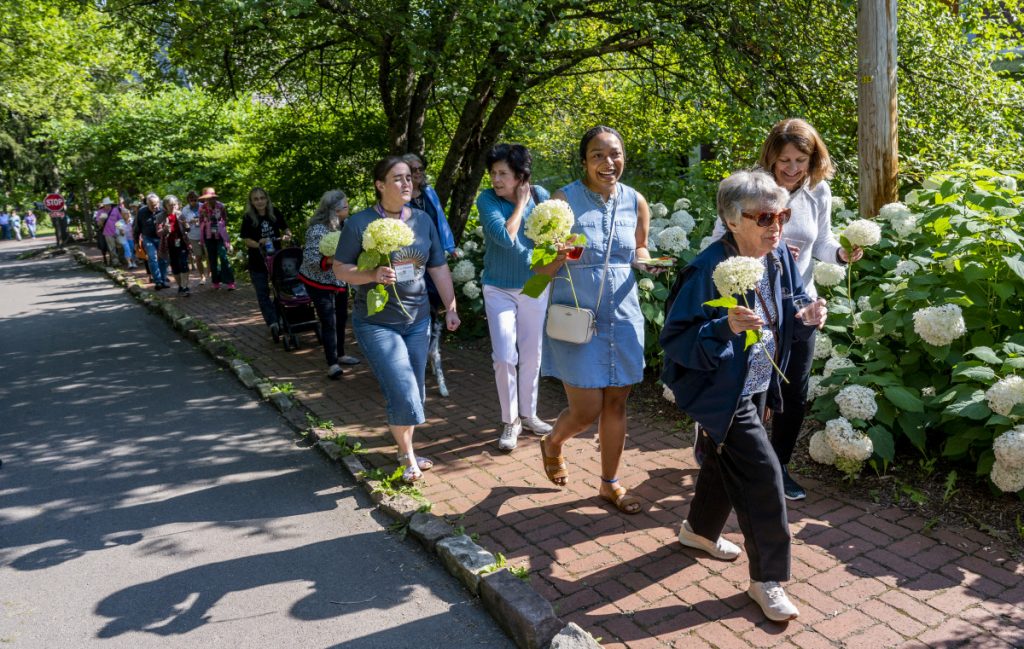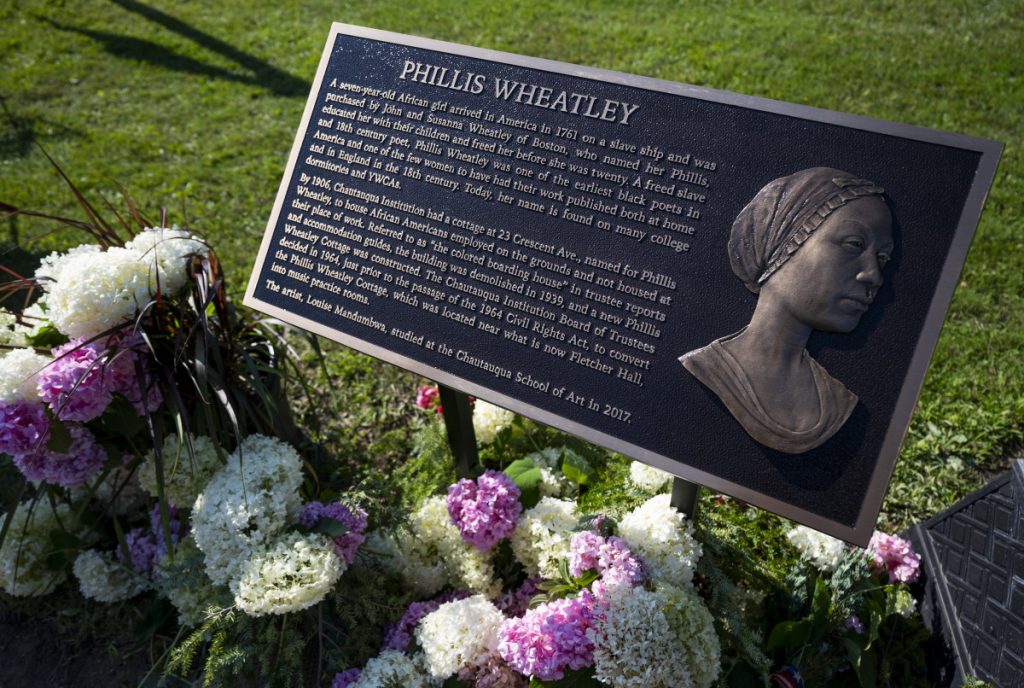LAURA PHILION – COPY & DIGITAL EDITOR

Inside Elizabeth S. Lenna Hall, there was a crowd — longtime Chautauquans, Institution leadership and newcomers came together to celebrate, thanks to some old papers, an aerial photograph and a story that spanned two continents.
Chautauquans gathered at 4 p.m. Wednesday, July 21 to attend the unveiling of a marker dedicated to Phillis Wheatley and the house which stood at Chautauqua in her name for more than 70 years.
There is no direct connection between Wheatley, a freedwoman and famous poet, and Chautauqua Institution. The Phillis Wheatley Cottage stood not as a commemorative place of learning, but as the “colored boarding house” for African American workers at Chautauqua.
“It’s true that African Americans have been well represented on the Amp stage, as preachers, speakers and entertainers,” said Ted First, African American Heritage House board member, during his remarks Wednesday. But First said Black Chautauquans are not often remembered as “members of our lived community.”
First said there were many questions about Chautauquan history that had yet to be answered, or even asked.
“The Phillis Wheatley Cottage offered the key to open that door, but she and it were buried in plain sight, in the archives — in small type, classified ads, old maps, building and grounds reports, reams of newspapers with around-the-grounds, back-page news,” he said.
The marker was installed at the approximate location of the Phillis Wheatley Cottage — but even the address is the source of some doubt.
“We don’t actually know the date (the Cottage) was opened, or what year,” First said.
The Cottage was first created sometime in the 1890s. It’s known definitively that the Cottage was located at 23 Crescent in 1906, but was likely relocated during renovations in 1939, close to what is now Fletcher Music Hall. In a 1921 building and grounds report, the Cottage’s repair expenses are detailed: The report states, “The colored boarding and rooming house now presents a fairly good appearance, and I think quite satisfactory to the people who occupy it.”

By the 1940s, there was an official hostess of the Wheatley Cottage, and boarders made regular collective contributions to Old First Night each season. In 1965, the building was officially repurposed as practice and storage space with the passage of the Civil Rights Act. Forty-five years ago, First said, it was demolished — without a single known photograph ever taken of it.
When the history of such a house was brought to the attention of the AAHH in 2018, its leaders immediately helped organize efforts to uncover more of the story. That job fell to Emálee Sanfilippo, assistant archivist at the Oliver Archives Center. This has been her project for the last three years, and it is due to her efforts that personal and classified ads mentioning the Wheatley Cottage have been unearthed. Sanfilippo also verified the identities of many Black graduates of the very first Chautauqua Literary and Scientific Circle class of 1882.
Phillis Wheatley herself was born in West Africa around 1758. Her original name was lost to history, and in 1761 she made the brutal passage to America as an enslaved child. She was bought in Boston by John Wheatley, who named her Phillis, after the ship she arrived on.
“She was brought to Boston to accompany Susanna (Wheatley), in the education and vested care of her children,” First said. “In the process of that, she got to accompany the lessons — and within 18 months, at the age of 7, she mastered the English language: reading, writing, in all its forms.”
Wheatley was freed at the age of 20. She became a renowned poet, but died in relative poverty and anonymity before she reached middle age. She is remembered today as a groundbreaking early American, but her legacy is not often closely examined.
“All of our archival research continues to unfold the full history of African Americans at Chautauqua,” First said. “We know that during the period when Chautauqua was in full bloom, from 1907 to 1925, Chautauqua engaged 50 million individuals with its national reach. … African Americans were present in all of these expressions in significant numbers.”
First closed his remarks by emphasizing the importance of uncovering hidden histories and fully illuminating buried narratives.

“Today’s dedication liberates Phillis Wheatley, and brings her on(to) the grounds,” he said. “She’s now a Chautauquan — no longer lost in the archives. Her story has been the key to unlock the door to the African American narrative; through that door, we have a path to understanding where we’ve been, and better how to embrace the future together.”
Louise Mandumbwa, who created the marker to be unveiled, is a painter, printmaker and draughtswoman, and an alumna of Chautauqua Visual Arts’ 2019 season. Born in Botswana, Mandumbwa traveled to the United States to complete her bachelor of fine arts degree from the University of Central Arkansas, where she met Sharon Louden, the Sydelle Sonkin and Herb Siegel Artistic Director. Louden encouraged Mandumbwa to participate at CVA, and gave her name when plans were made to design a commemorative marker.
In her short remarks, Mandumbwa thanked Elaine Davis, a driving force behind AAHH and these efforts; First; and Louden “for the opportunity, as an African in America, to experience (and) really learn this story for the first time.”
“I know that people in this room — maybe more than other people in different spaces — appreciate that stories are not frivolous,” she said. “We learn from them. The stories we tell ourselves and tell each other inform how we see one another.”
Mandumbwa said that once people see each other, they are able to live full and beautiful lives as individuals, and that she hopes she has brought some of that individualism back to Phillis Wheatley, who “managed to shine so brightly” while facing incredibly difficult circumstances.
“It has been a complete honor,” she said, “to revisit this individual — to bring light back into her eyes.”
To open and close remarks, the Chautauqua Symphony Orchestra Diversity Fellows played three classical pieces: “4 for Tango,” by Astor Piazzolla, “Por Una Cabeza,” by Carlos Gardel, and a selection from Michael Haydn. The Diversity Fellows are Yan Izquierdo (violin), Scott Jackson (violin), Edna Pierce (viola), Max Oppeltz (cello) and Amy Nickler (double bass).
Following a short reception, attendees walked up the hill past Fletcher Hall to the intersection of Harris and Palestine. Fresh hydrangea blooms were handed out; the walk up the hill turned both joyful and processional. Davis and Mandumbwa unveiled the marker together to enthusiastic applause.



